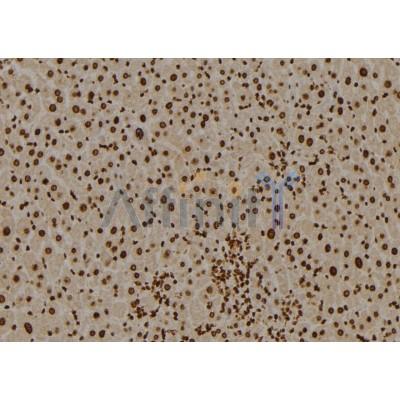BCL10 Antibody - #DF3606
| Product: | BCL10 Antibody |
| Catalog: | DF3606 |
| Description: | Rabbit polyclonal antibody to BCL10 |
| Application: | WB IHC |
| Reactivity: | Human, Mouse, Rat |
| Prediction: | Pig, Bovine, Horse, Sheep, Rabbit, Dog, Chicken |
| Mol.Wt.: | 36 KD; 26kD(Calculated). |
| Uniprot: | O95999 |
| RRID: | AB_2835978 |
Related Downloads
Protocols
Product Info
*The optimal dilutions should be determined by the end user. For optimal experimental results, antibody reuse is not recommended.
*Tips:
WB: For western blot detection of denatured protein samples. IHC: For immunohistochemical detection of paraffin sections (IHC-p) or frozen sections (IHC-f) of tissue samples. IF/ICC: For immunofluorescence detection of cell samples. ELISA(peptide): For ELISA detection of antigenic peptide.
Cite Format: Affinity Biosciences Cat# DF3606, RRID:AB_2835978.
Fold/Unfold
AI132454; B cell CLL/lymphoma 10; B cell lymphoma/leukemia10; B-cell CLL/lymphoma 10; B-cell leukemia/lymphoma 10; B-cell lymphoma/leukemia 10; Bcl 10; Bcl-10; Bcl10; BCL10_HUMAN; c E10; c-E10; C81403; CARD containing apoptotic signaling protein; CARD containing molecule enhancing NF kappa B; CARD containing molecule enhancing NF kB; CARD containing molecule enhancing NF-kB; CARD containing molecule enhancing NFkB; CARD containing proapoptotic protein; CARD like apoptotic protein; CARD-containing apoptotic signaling protein; CARD-containing molecule enhancing NF-kappa-B; CARD-containing proapoptotic protein; CARD-like apoptotic protein; CARMEN; Caspase recruiting domain containing protein; caspase-recruiting domain-containing protein; cCARMEN; cE 10; cE10; CED 3/ICH 1 prodomain homologous E10 like regulator; CED-3/ICH-1 prodomain homologous E10-like regulator; CED3/ICH1 prodomain homologous E10 like regulator; Cellular E10; Cellular homolog of vCARMEN; Cellular-E10; CIPER; CLAP; hCLAP; Mammalian CARD containing adapter molecule E10; Mammalian CARD-containing adapter molecule E10; mE 10; mE10; R-RCD1;
Immunogens
A synthesized peptide derived from human BCL10, corresponding to a region within the internal amino acids.
- O95999 BCL10_HUMAN:
- Protein BLAST With
- NCBI/
- ExPASy/
- Uniprot
MEPTAPSLTEEDLTEVKKDALENLRVYLCEKIIAERHFDHLRAKKILSREDTEEISCRTSSRKRAGKLLDYLQENPKGLDTLVESIRREKTQNFLIQKITDEVLKLRNIKLEHLKGLKCSSCEPFPDGATNNLSRSNSDESNFSEKLRASTVMYHPEGESSTTPFFSTNSSLNLPVLEVGRTENTIFSSTTLPRPGDPGAPPLPPDLQLEEEGTCANSSEMFLPLRSRTVSRQ
Predictions
Score>80(red) has high confidence and is suggested to be used for WB detection. *The prediction model is mainly based on the alignment of immunogen sequences, the results are for reference only, not as the basis of quality assurance.
High(score>80) Medium(80>score>50) Low(score<50) No confidence
Research Backgrounds
Involved in adaptive immune response. Promotes apoptosis, pro-caspase-9 maturation and activation of NF-kappa-B via NIK and IKK. May be an adapter protein between upstream TNFR1-TRADD-RIP complex and the downstream NIK-IKK-IKAP complex. Is a substrate for MALT1.
Phosphorylated. Phosphorylation results in dissociation from TRAF2 and binding to BIRC2/c-IAP2. Phosphorylated by IKBKB/IKKB.
Cytoplasm>Perinuclear region. Membrane raft.
Note: Appears to have a perinuclear, compact and filamentous pattern of expression. Also found in the nucleus of several types of tumor cells. Colocalized with DPP4 in membrane rafts.
Ubiquitous.
Research Fields
· Environmental Information Processing > Signal transduction > NF-kappa B signaling pathway. (View pathway)
· Human Diseases > Infectious diseases: Bacterial > Tuberculosis.
· Organismal Systems > Immune system > T cell receptor signaling pathway. (View pathway)
· Organismal Systems > Immune system > B cell receptor signaling pathway. (View pathway)
Restrictive clause
Affinity Biosciences tests all products strictly. Citations are provided as a resource for additional applications that have not been validated by Affinity Biosciences. Please choose the appropriate format for each application and consult Materials and Methods sections for additional details about the use of any product in these publications.
For Research Use Only.
Not for use in diagnostic or therapeutic procedures. Not for resale. Not for distribution without written consent. Affinity Biosciences will not be held responsible for patent infringement or other violations that may occur with the use of our products. Affinity Biosciences, Affinity Biosciences Logo and all other trademarks are the property of Affinity Biosciences LTD.




